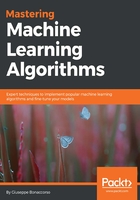
Features of a machine learning model
In this section, we're going to consider supervised models, and try to determine how it's possible to measure their theoretical potential accuracy and their ability to generalize correctly over all possible samples drawn from pdata. The majority of these concepts were developed before the deep learning age, but continue to have an enormous influence on research projects. The idea of capacity, for example, is an open-ended question that neuroscientists keep on asking themselves about the human brain. Modern deep learning models with dozens of layers and millions of parameters reopened the theoretical question from a mathematical viewpoint. Together with this, other elements, like the limits for the variance of an estimator, again attracted the limelight because the algorithms are becoming more and more powerful, and performances that once were considered far from any feasible solution are now a reality. Being able to train a model, so as to exploit its full capacity, maximize its generalization ability, and increase the accuracy, overcoming even human performances, is what a deep learning engineer nowadays has to expect from his work.